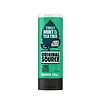What's inside
What's inside
 Key Ingredients
Key Ingredients

No key ingredients
 Benefits
Benefits

No benefits
 Concerns
Concerns

 Ingredients Side-by-side
Ingredients Side-by-side

Water
Skin ConditioningAmmonium Lauryl Sulfate
CleansingCaprylyl/Capryl Glucoside
CleansingCocamidopropyl Betaine
CleansingGlycerin
HumectantMentha Piperita Oil
MaskingCitrus Aurantium Dulcis Peel Oil
MaskingCananga Odorata Flower Oil
MaskingCitrus Aurantium Bergamia Peel Oil
Lavandula Hybrida Oil
EmollientPelargonium Graveolens Oil
MaskingAvena Sativa Kernel Extract
AbrasiveTilia Cordata Flower Extract
Skin ConditioningSambucus Nigra Fruit Extract
AstringentMaris Sal
Skin ConditioningSodium Benzoate
MaskingCitric Acid
BufferingCitronellol
PerfumingGeraniol
PerfumingLinalool
PerfumingLimonene
PerfumingWater, Ammonium Lauryl Sulfate, Caprylyl/Capryl Glucoside, Cocamidopropyl Betaine, Glycerin, Mentha Piperita Oil, Citrus Aurantium Dulcis Peel Oil, Cananga Odorata Flower Oil, Citrus Aurantium Bergamia Peel Oil, Lavandula Hybrida Oil, Pelargonium Graveolens Oil, Avena Sativa Kernel Extract, Tilia Cordata Flower Extract, Sambucus Nigra Fruit Extract, Maris Sal, Sodium Benzoate, Citric Acid, Citronellol, Geraniol, Linalool, Limonene
Water
Skin ConditioningSodium Laureth Sulfate
CleansingSodium Chloride
MaskingCocamidopropyl Betaine
CleansingParfum
MaskingCitrus Aurantifolia Oil
CleansingCitrus Sinensis Peel Oil Expressed
PerfumingPolyquaternium-7
Sodium Benzoate
MaskingTetrasodium Glutamate Diacetate
Lactic Acid
BufferingStyrene/Acrylates Copolymer
C11-15 Pareth-7
EmulsifyingC11-15 Pareth-40
CleansingDiethylamino Hydroxybenzoyl Hexyl Benzoate
UV FilterEthylhexyl Methoxycinnamate
UV AbsorberLimonene
PerfumingCI 19140
Cosmetic ColorantCI 42090
Cosmetic ColorantWater, Sodium Laureth Sulfate, Sodium Chloride, Cocamidopropyl Betaine, Parfum, Citrus Aurantifolia Oil, Citrus Sinensis Peel Oil Expressed, Polyquaternium-7, Sodium Benzoate, Tetrasodium Glutamate Diacetate, Lactic Acid, Styrene/Acrylates Copolymer, C11-15 Pareth-7, C11-15 Pareth-40, Diethylamino Hydroxybenzoyl Hexyl Benzoate, Ethylhexyl Methoxycinnamate, Limonene, CI 19140, CI 42090
Ingredients Explained
These ingredients are found in both products.
Ingredients higher up in an ingredient list are typically present in a larger amount.
Cocamidopropyl Betaine is a fatty acid created by mixing similar compounds in coconut oil and dimethylaminopropylamine, a compound with two amino groups.
This ingredient is a surfactant and cleanser. It helps gather the dirt, pollutants, and other impurities in your skin to be washed away. It also helps thicken a product and make the texture more creamy.
Being created from coconut oil means Cocamidopropyl Betaine is hydrating for the skin.
While Cocamidopropyl Betaine was believed to be an allergen, a study from 2012 disproved this. It found two compounds in unpure Cocamidopropyl Betaine to be the irritants: aminoamide and 3-dimethylaminopropylamine. High-grade and pure Cocamidopropyl Betaine did not induce allergic reactions during this study.
Learn more about Cocamidopropyl BetaineLimonene is a fragrance that adds scent and taste to a formulation.
It's found in the peel oil of citrus fruits and other plants such as lavender and eucalyptus. The scent of limonene is generally described as "sweet citrus".
Limonene acts as an antioxidant, meaning it helps neutralize free radicals.
When exposed to air, oxidized limonene may sensitize the skin. Because of this, limonene is often avoided by people with sensitive skin.
The term 'fragrance' is not regulated in many countries. In many cases, it is up to the brand to define this term. For instance, many brands choose to label themselves as "fragrance-free" because they are not using synthetic fragrances. However, their products may still contain ingredients such as essential oils that are considered a fragrance.
Learn more about LimoneneSodium Benzoate is a preservative. It's used in both cosmetic and food products to inhibit the growth of mold and bacteria. It is typically produced synthetically.
Both the US FDA and EU Health Committee have approved the use of sodium benzoate. In the US, levels of 0.1% (of the total product) are allowed.
Sodium benzoate works as a preservative by inhibiting the growth of bacteria inside of cells. It prevents the cell from fermenting a type of sugar using an enzyme called phosphofructokinase.
It is the salt of benzoic acid. Foods containing sodium benzoate include soda, salad dressings, condiments, fruit juices, wines, and snack foods.
Studies for using ascorbic acid and sodium benzoate in cosmetics are lacking, especially in skincare routines with multiple steps.
We always recommend speaking with a professional, such as a dermatologist, if you have any concerns.
Learn more about Sodium BenzoateWater. It's the most common cosmetic ingredient of all. You'll usually see it at the top of ingredient lists, meaning that it makes up the largest part of the product.
So why is it so popular? Water most often acts as a solvent - this means that it helps dissolve other ingredients into the formulation.
You'll also recognize water as that liquid we all need to stay alive. If you see this, drink a glass of water. Stay hydrated!
Learn more about Water